- Home
- Bonnye Matthews
Zamimolo’s Story, 50,000 BC
Zamimolo’s Story, 50,000 BC Read online
ZAMIMOLO’S
STORY: 50,000 BC
BOOK THREE OF
WINDS OF CHANGE,
A PREHISTORIC
FICTION SERIES ON
THE PEOPLING OF
THE AMERICAS
BONNYE MATTHEWS
PO Box 221974 Anchorage, Alaska 99522-1974
[email protected]—www.publicationconsultants.com
ISBN 978-1-59433-456-6
eISBN 978-1-59433-457-3
Library of Congress Catalog Card Number: 2014934071
Copyright 2014 Bonnye Matthews
Cover photo of Neanderthal – reconstruction, John Gurche; photo, Tim Evanson. Cover photo background is in the public domain, but attributable to Fiona Storey
Introduction images of doedicurus and glyptodon is in public domain, artist is R. Bruce Horstall; sloth in public domain, artist is Heinrich Harder; terror bird height comparison with man is in public domain, Shepherdfan; macrauchenia in public domain, author is Robert Bruce Horsfall; hippidion in public domain, author is Robert Bruce Horsfall; toxodon in public domain, author Robert Bruce Horsfall; stegomastodon in public domain, author Margaret Flinsch; cuvieronius Wikimedia license agreement Creative Commons Attribution 3.0, author is Sergiodlarosa; smilodon Wikimedia license agreement Creative Commons Attribution-Share Alike 3.0, author Sergiodlarosa.
All rights reserved, including the right of reproduction in any form, or by any mechanical or electronic means including photocopying or recording, or by any information storage or retrieval system, in whole or in part in any form, and in any case not without the written permission of the author and publisher.
Manufactured in the United States of America.
Dedication
for Randy Matthews
Contents
Acknowledgements
Introduction
Chapter 1
Chapter 2
Chapter 3
Chapter 4
Chapter 5
Chapter 6
Biblography
About the Author
Other Books in the Winds of Change Series:
Ki’ti’s Story, 75,000 BC
Manak-na’s Story, 75,000 BC
Acknowledgements
Without the assistance of several people, this book would not be. These people are, first, my brother, Randy Matthews, and then Sally Sutherland, Patricia Gilmore, Robert Arthur, and Pat Meiwes. Each contributed far in excess of what could be expected or hoped for based on family, friendship, or love of reading. I also thank my publisher, Evan Swensen, who had the courage to take on this project.
Introduction
Zamimolo’s Story, 50,000 BC is the third novel in the Winds of Change series that focuses on the peopling of the Americas. In this novel, a small group of the People migrates by boat to Central America from China/Mongolia. They have to adjust to environmental extremes, not only from temperature change, lack of seasonal variation to annual summer, but also to the entirely different set of living creatures in the environment. These include Volkswagen-sized armadillos and twenty-foot tall sloths.
I have also included the terror birds which were supposed to have gone extinct prior to 50,000 BC, but some remained into the 17,000 years ago range according to an article by Herculano Alvarenga and others in 2010. South America had been an island and wildlife was unique to that land in the way that the fauna of Australia or Madagascar differs from anything else on earth today. A few million years ago, the Americas connected via Central America. Despite the connection, South America remained a strange land. Animals did begin to migrate north from South America to North America and the other way around once the lands connected. The chart below provides an example of the size comparison of four species of terror birds and a human of today.
Other animals the People would have encountered were: the camel (macrauchenias) and horse (Hippidion),
the rhino-like toxodon that the Nola Nola call glar and stegomastodon,
the elephant (cuvieronius) and the smilodon.
Finally, the People had to adjust with no less impact to people from significantly different cultures whose mores did not necessarily match their own.
The novel series deals with two issues:
Clovis-First vs. Pre-Clovis Views
Clovis-First View: Clovis-First is an opinion that no humans were in the Americas until the Holocene (11,700 years ago to present). Proponents of that view are C. Vance Haynes, Aleš Hrdlička, Paul Martin, and Tim Flannery. The Clovis-First View recognizes no Pre-Clovis sites in the Americas. Along with the Clovis-First View is the idea that intelligence along with body shape evolved.
Pre-Clovis View: Pre-Clovis is an opinion that humans were in the Americas in the Pleistocene (2.6 million to 11,700 years ago), and may have been present here as far back as hundreds of thousands of years ago. Pre-Clovis proponents are: Thomas Dillehay, James Adovasio, Christopher Hardaker, and Michael Cremo. They point to some 400 Pre-Clovis sites in the Americas, a few of which are shown on the chart on page 8. This view conceives that humans have always had the same level of intelligence; they just applied it to different sets of circumstances and built on different bases.
The Intellectual Level and Life Styles of Neanderthals
Neanderthals have been viewed as hunched over, dark-skinned brutes without the function of spoken language. We know today that Neanderthals had fair skin, and some had red hair and blue eyes; could speak as well as we can; were intellectually bright (catching dolphins, something which can’t be done from shore); killed mega fauna with spears; and survived temperatures that would challenge our best outdoors men and women today; buried their dead with red ochre and flowers; and cared for their disabled. It might be noted that many people today carry residual Neanderthal DNA.
The series explores the Pre-Clovis View and speculates on the mores and lifestyles of a People who could endure for hundreds of thousands of years without killing off others or their own kind. The series demonstrates how the various humans might have merged Neanderthals, Homo erectus, Cromagnons, and Denisovans—raising the question whether these groups are the same species, since they can reproduce viable young (at this point the Homo erectus connection is unproven lacking DNA from Homo erectus).
Zamimolo’s Story, 50,000 BC begins with an abduction, because the People don’t know the signs of the animal life, having just arrived in Central America. The People fail to realize silence in the bugs and frogs reflects an observed change in the environment. The abduction has a profound effect on Zamimolo, one of the leaders of his People. Can the ways of other groups of people affect the mores and actions of the People? Read to discover.
Caution: The books in this series contain numbers of people. Some readers lose the story trying to grasp every name. As a writer, I could not chop the characters out, because they have function and/or they are part of a family, but some are just not vital. After studying this issue, I have taken the chart showing the families and people of groups, and I marked the names of those whose roles are the most relevant in bold type. Some characters may not even be listed on the chart. I’d urge readers just to keep reading when the names become a little difficult. There’s no need to fix every name. Check with the chart, if you have questions.
Zamimolo’s Story, 50,000 BC contains a bibliography.
For more information see: http://booksbybonnye.com
For a compilation of articles regarding early man, see my Author Facebook page at:
Facebook: https://www.facebook.com/pages/Bonnye-Matthews/484231424985849?ref=hl#
Chapter 1
There was a hush among the People. The only sounds were from the waves crashing on the shore below them, the light wind, a few frogs
just beginning to break the peace in the distance, night bugs, and the crackling fire. The hunters sat cross-legged on flat stones that gathered into a semi-circle reflecting their former cave arrangement for council meetings. The women sat on skins laid on the sand just beyond the men. Children sat or reclined on skins with their mothers. It was as yet a moonless night but the profusion of stars provided light from the cloud-free sky. It was their first night in their new land. Glad to be off the boat and on land again, there was not a single complaint heard all day—even when the boat left.
The Wise One, who sat at the forefront near the fire, his bundle from the ancients beside him, remained silent for a long time as he pieced together memories of the rugged long boat trip to this new land. Something troubled his spirit, but he couldn’t identify the cause. He put his hand on the leather bundle. Only rarely did he unwind it. The bundle contained a piece of a meteorite, a yellow rock owl that seemed to glow, a gold nugget, a piece of jade, a purple sea shell with holes along one side, a piece of a grouping of white crystals, and many other small special things. There was a tiny piece of animal gut folded to hold some black dust that was supposed to be a feather. It was reputed to hold much power. Some legends said it was from a raven from the time when animals and humans talked to each other. The Wise One had no idea of the meaning of all the items in the bundle, only that he was charged with keeping them because they had been with the People since the beginning of time.
Despite the still and quiet, the Wise One’s mind web raced backwards through time as far as he could go in his life and then almost regrettably turned and came forward to this place by the sea. His pathetically thin frame showed his bones in sharp contrast to the normally well-fleshed People. Across the sea to the west from where they’d come, he’d been covered with skins to keep the cold away. Here he shed the skins that covered him in favor of a leather loincloth only because of the oppressive heat. The People were silently shocked at how emaciated he’d become. They had seen his sunken cheeks, but his chest showed every rib and his bones protruded just below his waist. His beard was scant. He had little hair atop his head. The tops of his ears stuck out as they always had. Some of his teeth were missing. Yet the man at age seventy still retained a mind web sharper than anyone else. The People saw him as something more than a man, though they’d never have said that aloud. To them he’d always been there and would always be there. He had to be. There was no one to replace him. He was their rock on land, anchor on the sea.
The starry sky reminded the old man of the glowing light in the water he’d sometimes seen, as their boat progressed to this new land. Sparks from the flames seemed to aim for the sky to join the twinkling lights there. A sense of auspicious delight infused the tired People. To find a new home with warmth after the cold temperatures they’d survived for so long was a relief.
“Has he nodded off?” Oaq asked quietly with an elbow poke to his brother, Ekemento.
“I don’t think so,” Ekemento whispered back.
Uilo, their mother, used a hand sign to quiet them.
Zamimolo smiled at Olomaru-mia from across the other side of the semi-circle. Zamimolo had dark brown hair, almost black. His gently sloping forehead and brow ridges showed his ancestry lay with the old People. His father was fully old People from the extreme far west. He looked just like his father except for eye color. His eyes were brown; his father’s, dark blue. Olomaru-mia was also part old People and Minguat. Her light red hair mixed with gold was her crowning beauty. Her eyes were green. They remembered the characteristics of People, though they’d been told that all were People and differences were not important from the beginning of time. Each had a sense of ancestry simply from the traits they bore. Olomaru-mia’s hair was long and hung in tight spirals to her waist. It was soft and she kept it clean and shining, fully combed. Zamimolo sat on the far other side of the semi-circle from her with nothing blocking their view of each other. They would join in a few days when the People settled into their new location. They had waited for a long time and now that the sea trip was behind them, they would spend the rest of their lives joined. Olomaru-mia smiled back at Zamimolo and tilted her head in the way that melted his belly. Her smile told him how she loved him. His smile returned the message. She sat on the far outside edge of the group watching her little sisters, Flanilk and Picota. She decided to make a quick trip to the privy before the meeting began, so she asked Milukima, her fourteen-year-old sister, to watch Flanilk and Picota while she relieved herself.
Linpint touched Zamimolo’s shoulder and asked, “Would you like to accompany me on a quick safety check of this country tomorrow to see if others are nearby? We also need to know what animals live here and what our dangers are. We’ve already seen some differences.”
“Of course,” Zamimolo replied, relishing a trip through the new country.
“Based on what Rustumarin and Golmid have seen, there appear to be no hearth fires in this area now, but others could have come here from time to time. We’d find traces. See that set of hills over there. I thought we might climb to the top to see what we can from the highest point.”
“First light?” Zamimolo asked.
“No reason to make it any later,” Linpint agreed.
The Wise One raised both arms to the sky. He cleared his throat. A few hunters noticed that even the bugs and frogs quieted for the old man. Silence was profound. The Wise One began, the silence broken by his voice.
“First let us thank Wisdom for our safe travel from our cold, old land to this warm, new land. We ask that Wisdom will keep us here as safely as in our old land and that our days will be long on the earth.” He paused. “And may I never have to travel the sea on a boat again!” He spat towards the fire. Laughter moved through the group. Almost everyone concurred.
A dark man moved silently up from an arroyo, crouching beside a wind shaped tree at a crest in the sand near the People. He didn’t move. He’d seen the girl leave the group, positioned himself, and waited, hardly breathing. Olomaru-mia heard the Wise One and rose to hurry back to the group. She passed a stunted tree growing in sea grass and fell to her knees, wondering at the sand on her lips as she fell into a deep sleep. The man had struck a blow as fast as a serpent strike to her left temple. He wrapped her hands in skins and tied them tightly at the wrists with several knots, each one tight. He placed a piece of leather into her mouth and secured it with a strap around her mouth, tying it at the back of her head, careful not to cut off her ability to breathe. He lifted her over his shoulders to hang like a speared deer around his neck and headed quickly towards the river’s edge always keeping to where he’d seen many people walk. He glanced furtively toward the light of the fire. There was no moon so the next few moments should tell whether he retained his prize or was discovered. His skin was far darker than that of these people and would not reflect much of the little light available. Hers would. He walked into the water not quite waist deep and began to move as quickly as possible upriver in that direction in the dark. He knew in a brief time he would be far beyond sight and there would be no tracks to follow. He wanted as much distance as he could gain before light. He counted on luck to get him as far south as the path that would lead to the mountain pass. He wanted to reach it before light. If he succeeded he could cross the mountain and the valley below before hunters could find his tracks—if his luck held. He was certain that once over the taller mountain, they’d never find him, but he had to do that undetected.
Back at the fire the story began. Zamimolo stared at the Wise One. He would listen carefully to every word, though he had heard the stories over and over. Each time to him it was as if they were new. He let go of the plans for the next day and gave all his thought to the Wise One.
The Wise One sat erect; he looked slightly up at the sky breathing deeply as he began, “This is a very, very old story. It is the story of Kukuk-na and Timkut-na. Timkut-na and Kukuk-na were hunters. They had trekked far looking for meat to feed the People. It was a time of drought and
meat was not easy to find.”
“The men went to places where they had known deer to gather. There were none. They went to places where trees grew in groves providing shade from the sun for animals. There were no animals there. They went to the highlands where they’d found grazers. There were none. They went to the lowlands and found nothing. Hunger was everywhere, but they were determined that they would not let their People starve, if they could help it.”
“Kukuk-na and Timkut-na were exhausted. They looked for a place to sleep. Wisdom was sucking color from the land fast. Below them was a grove of trees and they stumbled towards it. Timkut-na was the first to arrive. He noticed a spring that had not dried up. He kneeled and began to drink, for his thirst was great. Suddenly he felt a hit on his hand. A serpent had been harboring in the grass beside him, and it bit his hand. He noticed it was a cobra. He cursed himself for being so careless. Kukuk-na arrived. He saw what had happened, and Timkut-na showed him the direction the cobra had gone. Kukuk-na found the snake and killed it. He looked for others and found none. There was no cure for the bite. Either Timkut-na would live or die.”
“Kukuk-na tried to make a lean-to from what was available. He helped Timkut-na put out his sleeping skins and lie down. He made a fire. He handed Timkut-na a piece of jerky, but the hunter declined. He wasn’t hungry. Kukuk-na ate it. Timkut-na’s hand was beginning to hurt severely. He became nauseated and vomited, but there was nothing in his stomach to get rid of but a little water. His eyelids were drooping and his hand and arm were swelling. He was in obvious pain. Kukuk-na was agonizing over his friend. He kept the fire going and watched over Timkut-na carefully. Timkut-na slept fitfully. When Wisdom restored color to the land, Kukuk-na saw that Timkut-na was struggling to breathe. He saw him breathe his last.”

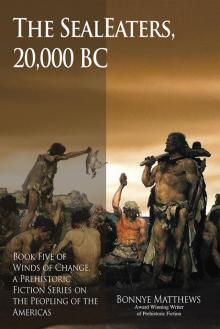 The SealEaters, 20,000 BC
The SealEaters, 20,000 BC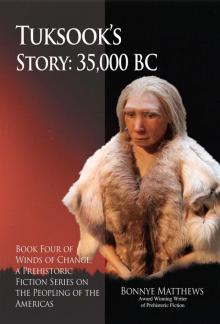 Tuksook's Story, 35,000 BC
Tuksook's Story, 35,000 BC Zamimolo’s Story, 50,000 BC: Book Three of Winds of Change, a Prehistoric Fiction Series on the Peopling of the Americas (Winds of Change series 3)
Zamimolo’s Story, 50,000 BC: Book Three of Winds of Change, a Prehistoric Fiction Series on the Peopling of the Americas (Winds of Change series 3)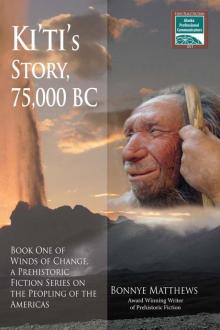 Ki'ti's Story, 75,000 BC
Ki'ti's Story, 75,000 BC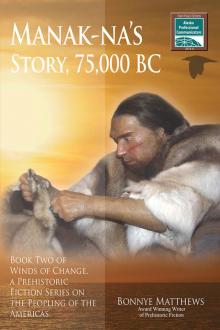 Manak-na's Story, 75,000 BC
Manak-na's Story, 75,000 BC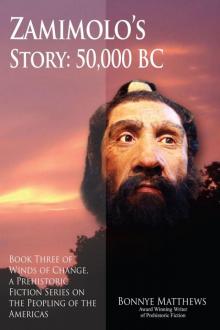 Zamimolo’s Story, 50,000 BC
Zamimolo’s Story, 50,000 BC